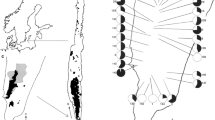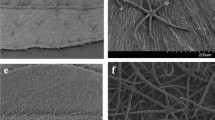Summary
-
1.
The garden forms of “Verbena hybricla” show variations of two kinds, the first apparently derived from differences between its four reputed parental species, the second -from mutations which have taken place since the original hybridization about a hundred years ago.
-
2.
The second group depends on ten gene differences, which show complete dominance of a common wild type. The first group on the other hand depends on eight gene differences which show various degrees of dominance.
-
3.
There are two sets of triple allelomorphs controlling colour, which are remarkable in that the extreme members of each series determine the same phenotype and differ only in that one is dominant, the other recessive. to the intermediate allelomorph. Possibly the dominant member is derived from a species difference, the recessive from mutation.
-
4.
Aberrant ratios, modifying factors and extremely close linkages occur with exceptional frequency and are probably due to the hybrid origin of the group.
The pigment chemistry will be described later. I would be most grateful if collectors or others in South America would supply seeds from the wild of any species mentioned in this paper, or any other closely related species.
Similar content being viewed by others
References
ApieT, A. (1936). “Some evolutionary aspects of a comparative cytogenetic investigation betweenAconihtm and Soianum. ” Genetica,18, 255–76.
Bailey, L. R. (1902).Cyclopedia of American Horticulture, 4.
Dahlgren, K. V. O. (1924). “Kreuzungskleinigkeiten. Versuche mitGeum rivale.”Hereditas, Lund., 5, 222–30.
De Candolle, A. (1847).Prodromus systematic naturalis,11, 535–57.
Dermes, H. (1936). “ Cytological study and hybridization in two sections ofVerbena.” Cytologia Tokyo,7, 160–75.
Emerson, R. A. &Anderson, E. G. (1932). “The A series of allelomorphs in relation to pigmentation in maize.”Genetica,17, 503–9.
EmswelLer, S.L. &Blodgett, C. O. (1937). “Inheritance studies of a dwarf mutant inVerbena.” Proc. Amer. Soc. hart. Sci.35, S22–4.
Harland, S. G. (1936). “The genetical conception of species.”Biol. Pev.11, 83- 112.
—— (1939).The Genetics of Cotton. London: Cape.
Kühl, O. (1937). “ Genanalyse beiAntirrhimtm-Artibstaren.” Z. Incluid. Abstamm. u. VererbLehre,74, 125–60.
Lecogq, H. (1852). “Culture des Verveines comme plantes annuelles.Rev. hort.4, 5–12.
Mather, K. (1938).The Measurement of Linkage in Heredity. London: Methuen.
Matsuura, H. (1933).A Bibliographical Monograph of Plant Genetics, 2nd ed. Sapporo.
Noack, K. L. (1937). “Die Chromosomenzahleneiniger Verbena-Arten.”Biol.Zbl.57, 383–88.
Silow, R. A. (1939). “The genetics of leaf shape in diploid cottons.”J. Genet.38, 229–76.
Winge, Ö. (1937).Arvelighedslaere. Copenhagen.
Author information
Authors and Affiliations
Rights and permissions
About this article
Cite this article
Beale, G.H. The genetics ofverbena. I. Journ. of Genetics 40, 337–358 (1940). https://doi.org/10.1007/BF03028225
Issue Date:
DOI: https://doi.org/10.1007/BF03028225




